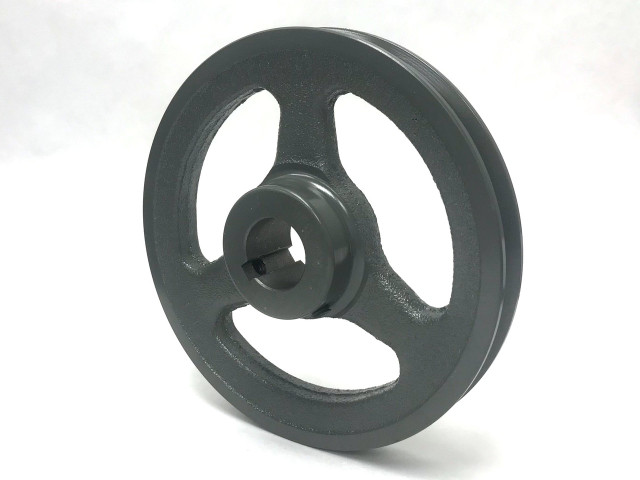Cast Iron Pulley Manufacturer
The pulleys are generally made of cast iron, because of their low cost. The rim is held in place by web from the central boss or by arms or spokes. The arms may be straight or curved as shown in Fig. 1 (a) and (b) and the cross-section is usually elliptical.
When a cast pulley contracts in the mould, the arms are in a state of stress and very liable to break. The curved arms tend to yield rather than to break. The arms are near the hub. The cast iron pulleys are generally made with rounded rims. This slight convexity is known as crowning. The crowning tends to keep the belt in centre on a pulley rim while in motion. The crowning may be 9 mm for 300 mm width of pulley face.
The cast iron pulleys may be solid as shown in Fig. 1 or split type as shown in Fig. 2. When it is necessary to mount a pulley on a shaft which already carrying pulleys etc. or have its ends swelled, it is easier to use a split-pulley.
There is a clearance between the faces and the two halves are readily tightened upon the shafts by the bolts as shown in Fig. 2. A sunk key is used for heavy drives.

Cast Iron Pulley Manufacturer
Cast Iron Pulley
Our GG 25 gray cast iron and GGG 50 nodular cast iron pulleys (Elevator Wheels) are used in tackle, deflection and hydraulic pulleys.
We have models in any size casting pulleys which we suggest for lower-speed elevators and they are delivered in desired sizes after manufactured with metal cutting in our workshop according to demands of our customers.
Also read:- Civil Engineer Interview Questions and Answers
Tackle Pulley
Plastic Tackle Pulleys (Plastic Elevator Wheels) are the pulleys which transmits the movement from the lift motor. They are used above and below the cabin as 1/1 or 2/1 hanger.
Cast iron and v-belt pulleys are two commonly used types of pulleys in machinery and industrial applications. While both types of pulleys serve the same function, there are some key differences between them. In this article, we will explore the differences between cast iron belt pulleys and v-belt pulleys.
Cast iron belt pulleys are made from cast iron, a material known for its strength and durability. They are often used in heavy-duty applications, such as in agriculture, construction, and mining. Cast iron pulleys come in various sizes and shapes, including round, flat, and V-shaped. They are typically used with flat belts or V-belts and can transmit high levels of power without slipping.
V-belt pulleys, on the other hand, are specifically designed to work with V-belts, a type of belt with a trapezoidal cross-section. V-belts are commonly used in power transmission applications, such as in HVAC systems, agricultural machinery, and automotive engines. V-belt pulleys are usually made from steel, aluminum, or plastic, and come in a variety of sizes and shapes.
One of the main differences between cast iron belt pulleys and v-belt pulleys is their material composition. Cast iron pulleys are made from cast iron, which is a dense and strong material that can withstand heavy loads and high speeds. V-belt pulleys, on the other hand, are made from lighter materials such as steel, aluminum, or plastic, which are better suited for high-speed applications where weight is a concern.
Another difference is the way they work. Cast iron pulleys are typically used with flat belts or V-belts, while V-belt pulleys are specifically designed to work with V-belts. V-belt pulleys have a unique V-shaped groove that matches the cross-sectional shape of the V-belt, which helps to keep the belt in place and prevent it from slipping off the pulley.
In terms of maintenance, cast iron pulleys require more upkeep than V-belt pulleys. Cast iron is susceptible to rust and corrosion, so cast iron pulleys need to be properly lubricated and protected from moisture to prevent rust from forming. V-belt pulleys, on the other hand, require less maintenance, as they are made from materials that are less prone to corrosion and rust.
When it comes to cost, cast iron belt pulleys are typically more expensive than V-belt pulleys. This is due to the higher cost of the raw material, as well as the additional labor and manufacturing processes required to create cast iron pulleys.
In summary, cast iron belt pulleys and v-belt pulleys are two different types of pulleys that serve different purposes. Cast iron pulleys are typically used in heavy-duty applications that require high levels of strength and durability, while V-belt pulleys are designed for use with V-belts and are better suited for high-speed applications where weight is a concern. When choosing a pulley for a specific application, it is important to consider the specific requirements of the application, such as load, speed, and material compatibility, to ensure that the pulley is the right fit for the job.